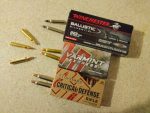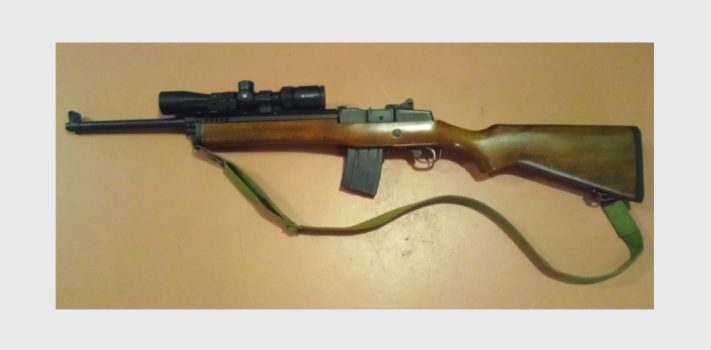This article describes my personal approach to setting up and testing a semi-auto scout rifle.
The “scout rifle” is a concept that has been around since the 1980s. First proposed by Colonel Jeff Cooper, it has become popular among outdoorsmen and survival-oriented folks as a “do-it-all” kind of rifle. Each person’s idea of a scout rifle can vary, with the purposes of self-defense and being able to take wild game common to your living area.
The original scout rifle concept has a very specific set of features. Cooper’s favorite caliber was, of course, the 308 Winchester / 7.62×51. He allowed other similar calibers such as 7mm-08 in the same power level. A scout rifle is supposed to be light, between 6.5 and 7.75 lbs, and have a short length of 39” or less. Scout rifles are typically magazine-fed bolt action, although Cooper’s original concept allowed for semi-auto operation if a sufficiently light action could be found. Forward-mounted, long eye-relief optics are the most noticeable feature of a scout rifle, typically from 2x-7x magnification. Scout rifles are supposed to be capable of 2 MOA or less, and are typically equipped with a Ching-style sling.
My Rifle and Modifications
My scout rifle concept matches my style of shooting and my specific needs. I have chosen the Mini-14 rifle as my platform, which is probably a controversial choice. So, why the Mini-14? Years ago, I worked for a state agency, and I trained with and was issued a Mini-14. I asked my instructors at the time why the Mini-14 was used instead of the AR-15. Mostly, it came down to durability and Ruger’s excellent customer service. At the time, a Mini-14 was also less expensive than an AR-15 rifle, although today the price difference has completely reversed! The wood and steel Mini-14 is more expensive.
My reasons for choosing the rifle are my own. After training with the rifle, I simply fell in love with it. I went out and bought a brand new one, and I have kept it as my general-purpose rifle ever since. I have other choices, but it is usually the Mini-14 that I grab when I am headed out the door for an unknown situation. The one time that I used a rifle in an armed altercation, it was my Mini-14 that kept me safe.
The Mini-14 also looks more “friendly” with its wood stock and lack of black plastic. If you live in an area with anti-gun sentiment or “assault rifle” restrictions, the Mini-14 is a good choice. You may have a different rifle that fills the same role in your life – personal preference and familiarity counts for a lot!
The Mini-14’s caliber is uncommonly light for a scout rifle. Some people do not consider the .223 Remington to be a good self-defense or hunting round. But the military equivalent (5.56mm NATO) has been proven effective in combat. Part of my scout rifle project involved testing of various .223 rounds to determine their usefulness. In my area, wild game does not get very large. Black bears and mountain lions are the apex predators, and they are small enough to take with a .223. I recall an incident in a nearby city a few years ago. A wandering black bear was dispatched in a suburban neighborhood by a police officer’s AR-15. If I lived farther west in brown bear country, then I would probably rethink my choice of caliber. So, just like the rifle itself, your scout rifle caliber choice is a matter of personal preference and the requirements of your area.
I started with a normal, off-the-shelf Ruger Mini-14. I made sure that it has a wood stock, as the Mini-14 I was issued by my agency had a black synthetic stock that got ridiculously hot in the summer sun. During training, most in my class fought over the two older Mini !4s with wood stocks, and the rest learned to bring gloves to handle the rifles in July. Not fun! The manufacturing date is also important. My rifle is a “580 series.” Ruger updated the Mini-14 in 2008, and the guns made since that time have a noticeably thicker, tapered barrel. They are much more accurate than the earlier ones, which had a reputation for stringing shots when they got hot.
The barrel on my rifle is 18.5” long, and without a flash hider. Perhaps a flash hider is important to some, but for me it is optional. The total weight of my gun is around 7.5 lbs, which is within scout rifle limits. Overall length is 38 inches. A stock Mini-14 has a 6-pound trigger pull, which I have lightened to a smooth 4 pounds, with a trigger job. I have found the rifle to be quite accurate in any shooting position, and I have commonly shot feral cats, possums, and raccoons with iron sights at up to 200 yards. As my eyes began to age, I wanted to update the rifle with a scope.
To add a forward-mounted scope to my rifle, I chose an Ultimak brand rail. I purchased the rail from the manufacturer’s website for around $140. Installation instructions were easy to follow, and all the installation tools (Allen wrenches) are included, making it very easy. Installation required me to field strip the rifle, as the rail clamps around the barrel near the chamber. No modifications to the stock were required. Once installed, the mount was very solid. I chose low-profile rings, and a Vortex Crossfire II 2x-7x scout scope for $200. Leupold has a similar offering as well, and normally I would have purchased that brand, but the scout model was out of stock everywhere at the time.
My biggest disappointment in my search for a scope was that none of the long eye relief scopes that I found had illuminated reticles. I probably spent 4 or 5 hours looking online, only for my search to come up empty. I prefer to have an illuminated reticle for low-light shots. You can compensate by having a laser on your rifle, but it is one more device to buy, install, and sight in. At the moment, I do not have a laser on my rifle. Once I had my Ultimak rail and my scope installed, I sighted it in on my range using a Caldwell lead sled. The rail and scope did not seem to change the performance of my rifle, and I found that the forward-mounted scope was wonderfully easy to use. Just like Jeff Cooper intended, I can keep both eyes open while shooting and it feels very natural. If the scope ever breaks, then I still have my trusty iron sights in place that I can use as soon as the scope is removed.
Here is a chart of how my scout rifle compares overall to Jeff Cooper’s ideal concept:
| Category | Cooper’s Rifle | My Rifle |
| Action | Bolt action | Semi-Auto |
| Feed | Magazine
Stripper Clip Guide |
Magazine only |
| Caliber | .308 or 7mm-08 | .223 |
| Weight | 6.5 – 7.75 lbs | 7.5 lbs |
| Length | 39” or less | 38” |
| Scope & Mount | Forward, 2x-7x | Forward, 2x-7x |
| Low-Light Capability | None | Flashlight |
| Accuracy | 2 MOA or better | 2 MOA |
| Trigger Pull | 3lbs | 4lbs |
| Sling | Ching Style | Standard strap |
| Stock | Synthetic preferred | Wood |
Choosing the Ammunition
 When I sighted in my rifle with the new scope, I used generic 55-grain ball ammunition. My rifle has a 1:9 twist rate, which is good for 45 to 62 grain bullets, but not so good for the heavier stuff. For the best accuracy, I chose to stick with the standard 55-grain weight for all my ammunition. One of the problems I found immediately is that much of the lighter-weight bullets are described as “varmint” bullets, meaning they are intended to fracture instead of penetrate. Not good for self-defense, and not good for larger game. That is one of the limitations of .223, but I’m happy to work within the limits of what the cartridge can do.
When I sighted in my rifle with the new scope, I used generic 55-grain ball ammunition. My rifle has a 1:9 twist rate, which is good for 45 to 62 grain bullets, but not so good for the heavier stuff. For the best accuracy, I chose to stick with the standard 55-grain weight for all my ammunition. One of the problems I found immediately is that much of the lighter-weight bullets are described as “varmint” bullets, meaning they are intended to fracture instead of penetrate. Not good for self-defense, and not good for larger game. That is one of the limitations of .223, but I’m happy to work within the limits of what the cartridge can do.
My first step was to go to my local gun shop and see what options were available. I had plenty of ball ammo and a lot of generic soft points, but I decided to buy some specialty rounds for testing purposes. I really wanted to get my hands on some of the Speer self-defense ammunition, but I could not obtain any with the ever-present ammunition shortages. I have also heard the Brown Bear .223 soft point ammunition worked well, but years ago I discovered that my Mini-14 will not cycle correctly with steel cases. I ended up getting some Winchester Ballistic Silver Tip, which is a bullet style that I love in 30-06. I found Hornady Critical Defense Rifle, as well as Hornady Varmint Express just for comparison. My final choice was a box of reloaded 55 grain Hornady soft points from a company called PNR, using Serbian Prvi Partizan brass cases. I normally do not buy premium hunting ammunition in .223, and I was displeased to see how expensive it was. Everything averaged at least a dollar per round, almost the cost of hunting ammunition for .308 or 30-06.
My second testing step was to put each round through my chronograph in five-shot groups. To my surprise, all my choices were practically identical in velocity at 3,200 feet per second, with a variation of only +/- 50 fps. All rounds cycled easily, with zero failures. That means that for the rest of my testing process, the only variables that changed were the style of bullets used and the test media. The fewer the variables, the more accurate the test results.
(To be concluded tomorrow, in Part 2.)










